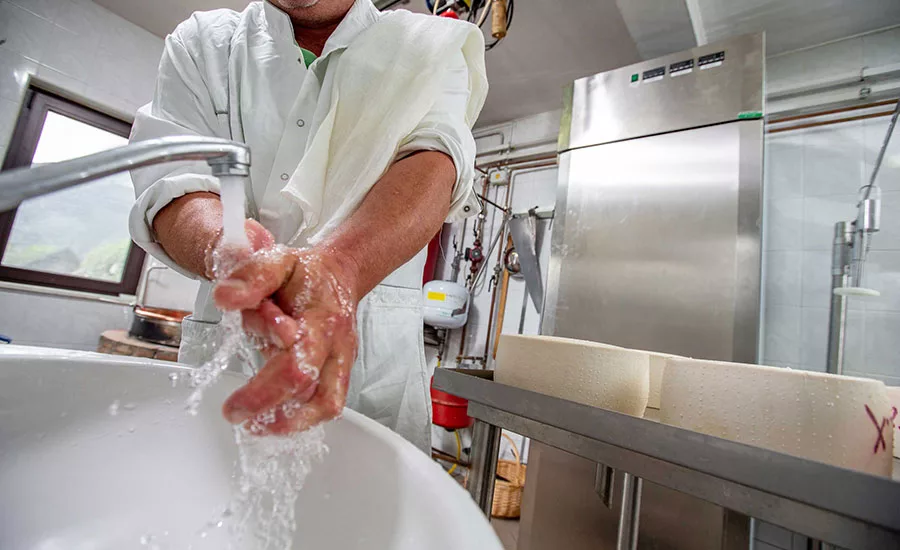Top Food Safety Priorities—Where are We Post-Pandemic?
There is still evidence in the economy and in our food industry of a "hangover" from the pandemic that we have not yet fully cleared

Image credit: CasarsaGuru/E+ via Getty Images
In the June/July edition of Food Safety Insights, we presented the first of our findings from the survey we conducted earlier this year on your views of your current top issues in your food safety program. That column focused on your opinions of the impending reorganization of the U.S. Food and Drug Administration's (FDA's) Human Foods program. In this article, we will explore what you see as the most pressing issues you are currently dealing with in your programs.
To address those issues, however, you need to have some level of stability and normalcy in your daily operations. One of the questions we asked suggested that many of you may still be in crisis mode.
The question we asked was: Are you fully recovered from COVID-19 and its impacts?
COVID-19 in the Rearview Mirror?
Okay, I know that you have probably heard all you care to hear about COVID-19. Me, too. But there is still evidence in the economy and in our food industry of a "hangover" from the pandemic that we have not yet fully cleared. When we asked about your current situation, most respondents said that they are recovered, but by a margin of 70 percent to 30 percent (Figure 1).
Of those saying that they are fully recovered, the news is pretty good. Most processors indicated that they are back to normal operations, with a few mentioning that they are now producing at levels that surpass what they were accomplishing pre-pandemic. Several mentioned that they are "back to normal," but still dealing with residual issues in their supply chain—a situation that one spice manufacturer described as "still out of our control." Others mentioned that personnel and hiring difficulties still persist, with one poultry producer saying, "…talent shortage and retention is still the biggest challenge remaining from COVID-19."
As one might expect, the story is far different from those indicating that they are not yet recovered. Staffing, supply chain, and inflation problems dominate the factors that are keeping them from recovery.
Most of the people in the "not yet recovered" category cited hiring and staffing issues as being the biggest impediments that they are facing (Figure 2). At least some of the labor problem is fueled by concerns about COVID-19 itself, including the potential for continuing or reemerging infections. One plant operations manager at a baked goods company said, "People are still hesitant to come in because the culture of coming to work sick still exists," with employees still fearful of working in proximity of ill coworkers who might continue to come to work infected with COVID-19. "Corporate American culture hasn't accepted that people should not come into work when they are sick," he added.
Looking for quick answers on food safety topics?
Try Ask FSM, our new smart AI search tool.
Ask FSM →
Most others, however, cited a simple lack of qualified applicants for open positions (Figure 3) as being a major issue. Many people said that some of their previous employees who left during the pandemic have not elected to return to work, and there is a shortage of new employees to replace them. Even those who are able to replace previous employees say that this is creating a skills deficit. One processor noted that they are not only working to return to a full staffing level, but also the "full experience level" they had before. Achieving both of those goals to return to full productivity will likely take more time.
Others cited persistent supply chain issues, all of which we have heard before. These issues include general shortages of supplies, delays in receiving shipments (especially from international/overseas shipments), deficient quality of available supplies, delays in approvals of alternate suppliers (when they can be found), and much higher prices for the products that they are able to source.
Some of the comments on staffing may help pull together these three main issues—staffing, supply, and inflation—that are delaying recovery. A typical story we heard was when food processors are able to find people to hire, the companies are having to pay higher wages to get them and continuous raises to retain them.
One snack food company mentioned that labor shortages at their suppliers have not only affected what raw material they can secure, but also their supplier's increased labor costs are being passed on as higher prices. This is exacerbated by supply shortages causing competition for too few goods, further driving those raw material prices even higher. This impact, along with costs from higher wages, is driving inflation down the chain.
Clearly, all of these issues are interconnected and are likely to unwind very slowly.
Some Pandemic Changes are Here to Stay
In a related question, we also asked about the most impactful permanent changes that you made in response to COVID-19. Nearly one-half of survey respondents cited changes in their policies for greater attention to employee hygiene and the use of personal protective equipment (PPE), as well as changes in policies for sick time and better definition for when people should or should not report to work (Figure 4).
The number-one personal hygiene change mentioned, by a wide margin, is an increased focus on handwashing. Many of the respondents mentioned that they had always paid attention to proper handwashing in production areas, and that had not changed. They are noticing, however, that their efforts to drive compliance during the pandemic may have resulted in improvements in handwashing compliance. Most reported that they have also permanently installed new handwashing stations throughout their facilities, including non-production areas and offices. This not only promotes hand hygiene among non-production employees, but also promotes handwashing compliance throughout the company, driving change in corporate culture.
Many also reported an increased focus on the use of PPE. As with handwashing, most reported that this was always a priority in production areas, but again, the increased focus related to virus control has also helped improve overall compliance. Several also reported that they have retained masking protocols, with some being mandatory and others voluntary. A few made special mention that they have taken efforts to remove any stigma with mask wearing for those that feel more comfortable using them. One QA/QC manager at a seafood company mentioned that they have a policy that "Masks are optional for healthy employees, except around employees who have a chronic illness or employees who specifically request it."
Others mentioned that they have retained social distancing measures, including 6-foot separations where possible and/or retaining the barriers that were installed during the pandemic. Many have also retained limits on office sharing and attendance caps to avoid crowded meetings. Several also mentioned continuing to employ staggered work shifts to limit the number of people present in the building at any one time.
The second most-mentioned change category was an increased focus on having employees stay home when they are sick or when they have any symptoms of illness. Respondents mentioned that their companies always had this as a "policy," but that enforcement and incentives are now better aligned to ensure that people comply. A production manager at a baked goods company mentioned, "We are doing what we can to make it clear to our employees that they are more valued when they take care of themselves when they are sick, meaning that it is okay when they stay home or work from home."
Another plant manager mentioned that they have "…improved their sick time policies while following a stricter policy for those with symptoms of illness." Several others mentioned that they have retained their policy for "routine temperature and oxygen level testing" for most employees, especially those that show symptoms.
In a similar light, 17 percent of respondents reported that they have continued to maintain an increased level of sanitation and cleaning, especially in non-production areas. Most people verified that cleaning and sanitation had always been appropriately emphasized in production areas, but that the increased attention and focus on non-production areas was new. One QA manager mentioned that they now have "weekly fogging of offices" for disinfection.
The same number of people (17 percent) mentioned retaining an increased use of remote work and the continued use of technology to limit personal contact. Commonly reported policies included remote auditing, online and remote training, non-production employees working from home, and more virtual meetings with suppliers and other partners to limit nonessential onsite visitors to the facility.
Looking Toward Further Recovery
It is worth mentioning that this survey was completed earlier this year—April 2023—and, hopefully, this recovery is continuing. It is clear, however, that all of these challenges will not be fully cleared in a short period of time. Also, as is evident from the survey responses, some changes will remain with us forever. However long it takes for this situation to normalize, we will continue to stay in touch with the progress and report our findings to you in Food Safety Insights.
In the next column, we will continue to explore more of what you told us about your current and near-term priorities for your food safety program, where you will be making investments in your program, and the regulations and issues you are watching that will have the most impact on your program in the future. Look for those details and more in the October/November issue of Food Safety Insights.
Bob Ferguson is President of Strategic Consulting Inc. and can be reached at bobferguson9806@gmail.com or on Twitter at @SCI_Ferguson.








